Scientists from the SLAC National Accelerator Laboratory have produced the world’s first 3,200-megapixel digital photos. The images were snapped by an oversized digital camera destined for the Vera C. Rubin Observatory in Chile, in what is an early demonstration of this facility’s tremendous potential.
A photograph containing 3.2 billion pixels is difficult to imagine. You would need 378 4K ultra-high definition televisions to display one at its full resolution, according to a SLAC press release.
Wow. Now imagine this power applied to astronomy. Happily, that’s exactly the plan, as the SUV-sized camera used to produce these images will eventually be installed on the Vera C. Rubin Observatory in Chile, which is likewise under construction.
Once Rubin is up and running (hopefully in the next year or two), the 3,200-megapixel digital camera, or more succinctly, the world’s first 3.2-gigapixel camera, will capture a succession of panoramic images of the entire southern sky, which it will do once every few days for 10 years. This project, known as the Legacy Survey of Space and Time (LSST), will track the motions of billions of stars and galaxies, while creating the world’s largest astronomical movie. This next-gen observatory is poised to shed new light on the formation of the universe, dark matter, and dark energy.

The new images, which can be seen here, were created as a test of the system’s newly completed focal plane, which serves as the “eye” of the camera. To take these photos, the team used a 150-micron pinhole to project images onto the focal plane. During tests, the SLAC researchers imaged various objects, including a head of romanesco — a type of broccoli with a highly detailed surface. Interestingly, the focal plane needs to be chilled in a cryostat chamber and brought down to -101 degrees Celsius in order for it to work properly.
The focal plane, which measures more than 0.61 m wide, contains 189 individual sensors, or charge-coupled devices, each of which can capture 16-megapixel images. Each light-gathering pixel is 10 microns wide — tiny, yes, but 10 times larger than the pixels in a typical camera phone (for reference, the average human hair is 50 microns wide). The focal plane is also super flat, measuring around a tenth the width of a human hair, allowing for exceptionally crisp, sharp images. Multiple sets of nine charge-coupled devices were assembled into squares dubbed “rafts,” of which 21 were installed onto the focal plane, along with four specialty rafts used for structural purposes. This required six months of careful work, as the rafts, which cost $US3 ($4) million each, are extremely fragile.

The specs on this digital camera are nothing short of remarkable. At 3,200-megapixels, it could resolve a golfball from 24 km away and its field of view is large enough to include 40 full Moons. It will be able to spot objects 100 million times dimmer than those visible to the unaided eye, which would be like seeing a candle from a few thousand miles away.
The SLAC researchers are planning to add the camera’s lens, shutter, and filter exchange system later this year. Once testing is complete, the device will be transported to Chile and installed on the Rubin observatory, which could happen as early as mid-2021. Should all go well, the LSST project will start in 2022 and run until 2032.
